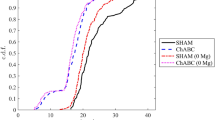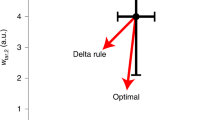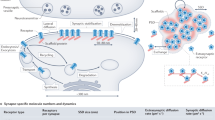Abstract
A BASIC premise of synaptic physiology is that neurotransmitter is released from motor nerve terminals in multimolecular packets called quanta1,2. The rate of release of quanta is low at rest, but when an action potential invades the nerve terminal there is a large increase in the mean rate of release leading to the generation of an endplate potential. It has been found that the distribution of the number of quanta released by an action potential is accurately described by a binomial distribution3–8. The assumption which underlies the binomial process is that n independent units (quanta) each have the same probability of success (release), p, on a single trial (stimulation). The parameters n and p can be estimated from the mean and variance of the binomially distributed variable. Although it is not clear what the physical correlates of n and p might be, it has been suggested that n may refer to the number of releasable quanta1, or to the number of release sites which can be activated on stimulation6. The changes in the apparent values of n and p which occur during synaptic processes such as facilitation6,8 and depression7, have been interpreted as providing evidence for particular mechanisms which may underly those processes.
This is a preview of subscription content, access via your institution
Access options
Subscribe to this journal
Receive 51 print issues and online access
$199.00 per year
only $3.90 per issue
Buy this article
- Purchase on Springer Link
- Instant access to full article PDF
Prices may be subject to local taxes which are calculated during checkout
Similar content being viewed by others
References
Fatt, P. & Katz, B. J. Physiol., Lond. 115, 320–370 (1951).
Martin, A. R. Physiol. Rev. 46, 51–66 (1966).
Johnson, E. W. & Wernig, A. J. Physiol., Lond. 218, 757–767 (1971).
Wernig, A. J Physiol., Lond. 226, 751–759 (1972).
Wernig, A. J. Physiol., Lond. 226, 761–768 (1972).
Zucker, R. S. J. Physiol., Lond. 229, 787–810 (1973).
Betz, W. J. J. Physiol., Lond. 206, 629–644 (1970).
Bennett, M. R., Florin, T. & Hall, R. J. Physiol., Lond. 247, 429–446 (1975).
Castelucci, V. & Kandel, E. R. Proc. natn. Acad. Sci. U.S.A. 71, 5004–5008 (1974).
Cohen, I. S., Kita, H. & Van der Kloot, W. J. Physiol., Lond. 236, 327–339 (1974).
Barrent, E. F., Barrett, J. N., Martin, A. R. & Rahamimoff, R. J. Physiol., Lond. 237, 453–463 (1974).
del Castillo, J. & Pumplin J. Physiol., Lond. 252, 491–508 (1975).
Author information
Authors and Affiliations
Rights and permissions
About this article
Cite this article
BARTON, S., COHEN, I. Are transmitter release statistics meaningful?. Nature 268, 267–268 (1977). https://doi.org/10.1038/268267a0
Received:
Accepted:
Issue Date:
DOI: https://doi.org/10.1038/268267a0
This article is cited by
-
Quantal analysis of long-term potentiation of combined neuronal postsynaptic potentials on hippocampal slices in vitro
Neurophysiology (1991)
-
Neurotransmitter release statistics: Moment estimates for inhomogeneous Bernoulli trials
Journal of Mathematical Biology (1979)
-
Quantum analysis of postsynaptic potentials
Neurophysiology (1979)
-
Transmitter release statistics are meaningful
Nature (1978)
-
Transmitter release statistics are meaningful (reply)
Nature (1978)
Comments
By submitting a comment you agree to abide by our Terms and Community Guidelines. If you find something abusive or that does not comply with our terms or guidelines please flag it as inappropriate.



